Bearing Service – the Key to Reliability
All forms of transmissions, transfer cases and differentials use anti-friction bearings to support moving components, reduce parasitic power losses and maintain the parts in their correct positions for long-term reliability. The most-common bearings we see in manual transmissions, transfer cases and differentials fall into several categories of design. Each type will have different design criteria as for operational speed and the ability to handle axial (thrust) and radial loads.

Testing the Speed Sensors in the AW55-50SN Transmission
A 2002 Volvo S60 arrived at our shop with two codes in the TCM: 0023 “Transmission input shaft speed sensor signal missing” and 0089 Transmission input speed sensor, signal too low.” The vehicle was in “limp-home mode,” which allows the transmission to be operated in 3rd and 4th gears only and with high line pressure. The customer had bought the vehicle with these conditions and did not know its history. Visual observation showed that someone had spliced into the speed sensors (Figure 1) and had replaced the transmission with a used one.
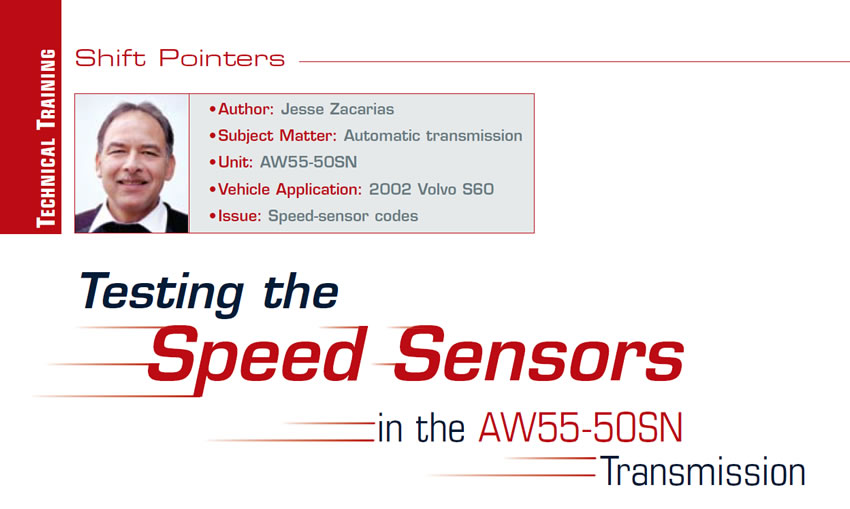
A Game of Winners and Losers
As a recruiter I am looking for three things: talent, attitude and a consistent work ethic. There are other attributes to consider, but that is what I am mainly interested in. That is what I think it takes to be a winner. As a recruiter for the shop, I know that If I can recruit people with those three qualities I will have done my job.

The Stigma of Sales
There are two kinds of people in the world – cat people and dog people. Wait, no. That’s not the point of this article. There are two other kinds of people in the world – people who love sales and people who hate sales. And, then, there are those who hate salespeople and those who love salespeople. From my own experience, I have found that there are far more Americans who detest salespeople than there are those who love (or even like) salespeople.

Vacuum Testing GM 4T65-E
From the TASC Force we reprint a series of in-depth test instructions for checking the serviceability of valve bodies.

March 2014 Issue
In This Issue
6L90 Reverse Delay: Is a Partial Repair Appropriate?
4L60E harsh 1-2 shift: New builders, old problems
AW55-51SN Valve Body Issues: Valve Body – Replace or Gamble?
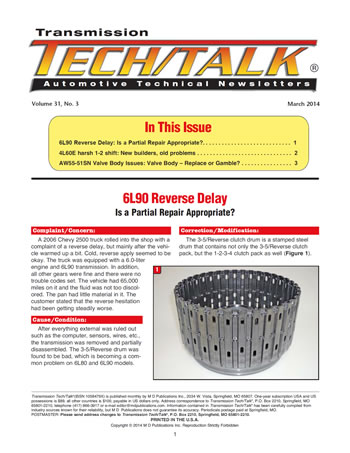
Automatic-Transmission Fluid: What is today’s reality?
Long gone are the simpler times of having just one or two types of transmission fluid. Throughout the 1950s, ’60s and early ’70s, there were basically GM type A or type A “suffix A” and Ford type F. Because of a changing environment, such as increasing engine/transmission temps as well as a fluid-component issue (remember the ban on sperm-whale oil), fluid started to evolve.
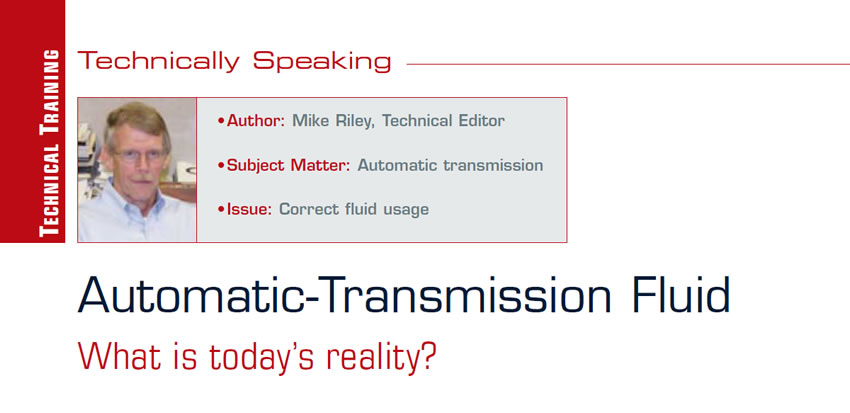
Blame it on the Torque Converter
A 2006 Chrysler 300 AWD came into our shop with a shudder concern. The vehicle was equipped with a 5.7-liter hemi engine coupled with a Mercedes 722.6 transmission, and it had 84,751 miles on the clock. The customer brought it to us for a second opinion. Prior to the visit to our shop, the customer had taken the vehicle to a Chrysler dealer for evaluation. The dealer had diagnosed the problem and determined that a torque-converter replacement was in order.
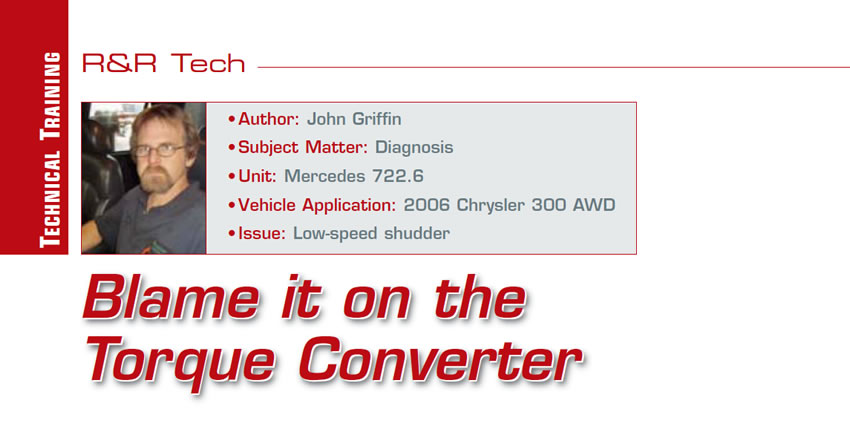
Trucks Aren’t the only Vehicles with 4-Wheel Drive
In this article we look at the BorgWarner 4476 and 4479 transfer cases, which are all-wheel-drive units. All-wheel drive signifies that the car has the ability to send power to all four wheels all the time with no driver controls. These transfer cases are essentially the same unit with some subtle differences and are found in the Cadillac SRX models. In 2004 all SRX models were equipped with the BW 4476. In 2005 this model was equipped with both the 4476 and 4479, and from 2006 through 2009 all were equipped with 4479 units.

You Don’t Have to Be a Salesperson to Make a Sale
The most important part of your business is making the sale. Your title, however, means little to anyone but yourself.

Technician Turned Sleuth
How often have you accepted a repair knowing that others have been involved? How often are you required to channel your inner Sherlock Holmes? Two recent repair jobs led me to unusual conclusions.
One of my customers brought in a Nissan Sentra that had a habit of blowing its interior-lamp fuse. She would replace the fuse, and then it could fail within hours, or it could take days before it popped.
Most of the time when I see blown fuses, there is a direct connection to either rubbed factory harnesses that aren’t routed with enough free play – sometimes accompanied by a TSB – or it is due to the intervention of human hands during a repair or modification, such as an aftermarket installation.
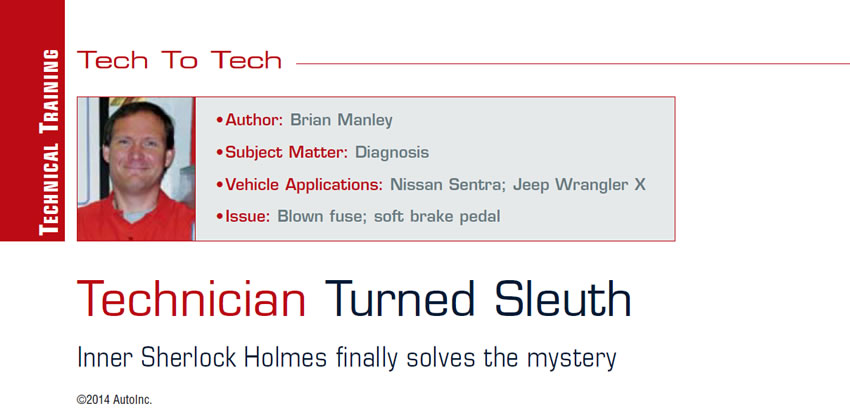
Analyzing Clues Solves TCC Mystery
The vehicle was a 1995 Ford Ranger 2WD, equipped with a 4R44E transmission. It had originally been repaired by a local transmission shop that had removed the unit and rebuilt it in house, though we had no knowledge of what the original complaint was at the time. After their repair, it would set a P0741 (TCC stuck off), OD light flashing etc. They’d had the vehicle for quite some time but then decided to purchase a remanufactured unit from one of our distributors when repairing the rebuilt unit was unsuccessful. After installation of the remanufactured unit, the same code and symptoms returned. It was then that the vehicle was brought to our shop for diagnosis.

